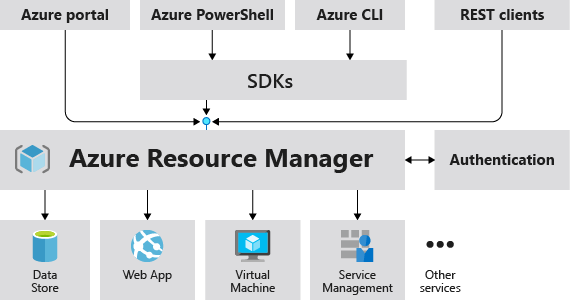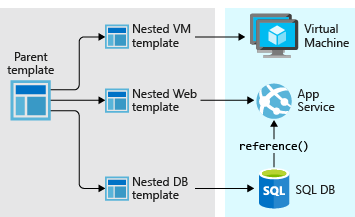
- Introduction
- Key Features of Azure Resource Manager
- Advanced Logging and Monitoring in ARM
- The Role of Resource Groups in ARM
- DevOps Integration and Continuous Deployment
- Deploying and Managing Resources with ARM Templates
- Security and Compliance in ARM
- Disaster Recovery and Business Continuity
- Cost Management and Optimization
- Sustainability and Green Cloud Computing with ARM
- Future Trends in ARM
- Conclusion
Introduction
Azure Resource Manager (ARM) is Microsoft’s management layer for Azure, allowing users to create, update, and delete resources within their Azure account. It is the cornerstone for managing the entire lifecycle of Azure resources, offering powerful capabilities for organizing, securing, and automating cloud infrastructure. ARM acts as a centralized management hub, enabling users to control and monitor their Azure resources from a single, unified interface. Whether it’s provisioning virtual machines (VMs), deploying databases, or configuring networking resources, ARM makes it easier to handle the complexity of cloud environments at scale, a concept that is thoroughly covered in Azure Training to help learners understand how to manage and optimize cloud infrastructure effectively. As cloud infrastructure continues to evolve, ARM serves as the central point of control, offering significant flexibility and agility. In this guide, we will explore the key features and best practices for leveraging ARM in 2025.
Interested in Obtaining Your Azure Certificate? View The Azure Training Offered By ACTE Right Now!
Key Features of Azure Resource Manager: Unlocking Powerful Cloud Operations
Azure Resource Manager is packed with features that simplify cloud resource management. Understanding these core features is essential for any Azure professional looking to optimize their cloud infrastructure in 2025.
Resource ManagementARM offers comprehensive resource management capabilities that allow users to organize and manage resources across multiple Azure subscriptions. Through ARM, you can perform actions like:
- Provisioning Resources: Easily deploy and manage Azure resources.
- Modifying Resources: Update and configure resources to meet changing business needs.
- Deleting Resources: Clean up unneeded resources to reduce costs and maintain an organized environment.
ARM supports declarative deployment models, which means you define the desired end-state of your resources, and ARM takes care of the rest. This simplifies the deployment process, ensuring consistency and reducing manual errors. For instance, you can define the infrastructure requirements in an ARM template and let the system automate the provisioning.
Access Control and SecurityWith ARM, you can implement detailed access control using Azure Role-Based Access Control (RBAC) and AWS IoT Solutions for Smarter, Connected Innovations. This allows you to define roles and permissions for users, ensuring that only authorized individuals can modify or interact with certain resources.
Tagging and Resource OrganizationTagging allows users to categorize resources according to specific criteria, such as department, environment, or project. This enables more efficient resource tracking and management, making it easier to report on usage, troubleshoot issues, and optimize spending.
Advanced Logging and Monitoring in ARM
Azure Monitor and Log Analytics provide extensive capabilities for tracking resource health, performance, and security in ARM. Organizations leveraging these tools can gain deeper insights into resource behavior, helping to proactively address potential issues before they impact business operations. Advanced logging enables administrators to track detailed event logs, monitor application performance, and integrate with security tools for anomaly detection. Additionally, ARM’s monitoring features facilitate proactive alerts, ensuring that system administrators are promptly notified of potential threats or performance bottlenecks. With real-time dashboards and AI-driven analytics, Azure Monitor helps businesses maintain system reliability, optimize resources, and improve incident response times.
The Role of Resource Groups in ARM: Organizing Cloud Resources Effectively
Resource groups are a fundamental organizational unit in ARM, allowing you to group related resources together. A resource group is essentially a container that holds related Azure resources for an application. These resources can be of different types, including virtual machines, storage accounts, and databases.
By logically grouping resources into resource groups, you can:
- Manage Resources as a Unit: You can deploy, update, and delete resources together in a single action, simplifying management, with Azure SSO to Secure and Scalable Authentication.
- Apply Access Controls: Apply security policies and permissions at the resource group level to control who has access to resources within that group.
- Optimize Cost and Monitoring: By tagging and categorizing resources within resource groups, it’s easier to monitor usage and allocate costs effectively.
- Consistency: ARM templates ensure that the same environment can be replicated multiple times without manual intervention.
- Automation: By integrating ARM templates with CI/CD pipelines, you can automate your entire resource deployment process, from development to production.
- Version Control: Templates can be stored in version control systems like Git, ensuring that you maintain a historical record of all infrastructure changes.
- Spending Patterns: Understand where and how money is being spent across Azure services.
- Budget Alerts: Set up budgets for different resource groups or subscriptions and receive alerts when your spending exceeds predefined thresholds. Resource Sizing and Optimization
- Enhanced Integration with AI and Machine Learning : We can expect ARM to become more integrated with artificial intelligence and machine learning technologies. These tools will help automate resource management, predict potential issues, and offer personalized recommendations for optimizing infrastructure.
- Further Improvements in Hybrid Cloud Management: With more organizations adopting hybrid cloud strategies, ARM will continue to evolve to manage resources across both on-premises and cloud environments seamlessly. This will provide greater flexibility for businesses looking to balance their workloads.
- Greater Focus on Sustainability:As environmental concerns grow, ARM will likely include more features aimed at reducing the carbon footprint of Azure resources, a topic that is often discussed in Azure Training to help professionals understand how sustainable practices can be incorporated into cloud infrastructure and resource management. This could include better reporting on resource efficiency and tools to manage energy consumption.

As organizations move towards more complex cloud architectures, ARM’s resource group model is increasingly valuable for keeping resources organized and ensuring seamless management across large teams and projects.
To Explore Azure in Depth, Check Out Our Comprehensive Azure Training To Gain Insights From Our Experts!
DevOps Integration and Continuous Deployment
ARM plays a crucial role in enabling DevOps practices by integrating seamlessly with continuous integration and continuous deployment (CI/CD) pipelines. Through Azure DevOps and GitHub Actions, developers can automate infrastructure deployments using ARM templates, ensuring consistency and reducing configuration drift. Infrastructure as Code (IaC) principles empower teams to version-control infrastructure changes, rollback updates when necessary, and maintain an audit trail for compliance. Additionally, ARM supports deployment slots, blue-green deployments, and canary testing strategies to facilitate smooth application updates with minimal downtime. By embedding ARM into DevOps workflows, organizations can achieve faster releases, improved collaboration, and a more agile cloud infrastructure.
Deploying and Managing Resources with ARM Templates: A New Era in Automation
One of the most significant advancements in cloud management is automation, and ARM templates are key to automating resource deployments in Azure, a topic extensively covered in Azure Training to help professionals master automation techniques and optimize cloud infrastructure management. ARM templates are JSON files that define the resources you need and their configurations, allowing you to deploy and manage your Azure infrastructure in a repeatable, automated manner.
Why Use ARM Templates?ARM templates support complex environments, making it easier to manage large-scale infrastructures. In 2025, the ability to define your infrastructure as code will be crucial for enhancing agility and minimizing human error in cloud operations.
Security and Compliance in ARM:
As security and compliance are more critical than ever in the cloud, ARM provides several features designed to enhance the security of your resources.
Role-Based Access Control (RBAC)RBAC is one of the primary tools in ARM for managing security. By assigning roles to users and groups, you can control access to resources, ensuring that only authorized personnel have the ability to manage them, while also leveraging Server less Computing Benefits & Uses. For instance, you could give a developer access to create virtual machines but restrict their ability to modify networking configurations.

ARM allows organizations to enforce compliance with organizational and regulatory standards through Azure Policies. These policies define rules and guidelines for resource creation and management, helping ensure that resources are configured according to best practices. For example, an organization could create a policy that only allows virtual machines to be deployed in certain regions or with specific configurations.
Azure Security Center IntegrationAzure Security Center provides advanced threat protection across your Azure resources. With ARM, you can integrate security center features directly into your resource management process, enabling real-time threat monitoring and automated responses.
Are You Considering Pursuing a Master’s Degree in Cloud Computing? Enroll in the Cloud Computing Masters Course Today!
Disaster Recovery and Business Continuity
Ensuring business continuity is crucial in cloud operations, and ARM supports organizations with robust disaster recovery mechanisms. Through integration with Azure Backup and Azure Site Recovery, ARM allows businesses to create automated backup policies, ensuring critical workloads and data are protected against accidental deletions, cyber threats, or natural disasters. The failover capabilities of Azure Site Recovery enable seamless migration of workloads across regions, reducing downtime and maintaining business operations even during outages. Additionally, ARM helps organizations implement geo-redundant storage solutions, ensuring high availability and data integrity. By leveraging ARM’s disaster recovery tools and Azure Data Box Secure Data Transfer Solution, companies can minimize service disruptions and guarantee smooth recovery processes in the face of unexpected events.
Cost Management and Optimization: Maximizing Cloud Efficiency with ARM
In the era of cloud computing, managing costs is essential. Azure Resource Manager offers several tools to help organizations control and optimize their cloud expenses.
Cost Management ToolsAzure provides robust cost management tools that integrate with ARM, allowing users to track and manage their resource consumption. These tools provide insights into:
ARM also helps in resource optimization by providing recommendations for resizing resources. For example, it may suggest downsizing virtual machines that are underutilized or switching to a more cost-effective storage solution.
Scaling ResourcesARM supports automated scaling of resources, meaning resources are scaled up or down based on demand. This ensures that you’re only paying for the resources you need, which is especially useful in dynamic environments.
Sustainability and Green Cloud Computing with ARM
As environmental concerns rise, ARM is evolving to support sustainability initiatives by providing insights into resource efficiency and carbon footprint reduction. Azure’s Sustainability Calculator, integrated with ARM, helps organizations track energy consumption and optimize cloud workloads for lower environmental impact. ARM also encourages sustainable cloud computing by promoting the use of serverless computing, auto-scaling, and energy-efficient VM sizing. By leveraging ARM’s monitoring tools and understanding MAC Addresses Functions, Risks, and Operation, businesses can analyze resource utilization patterns, eliminate wasteful resource allocations, and transition towards greener cloud strategies. As regulatory requirements for sustainability increase, ARM’s capabilities in carbon footprint tracking will be instrumental in helping enterprises meet environmental compliance standards.
Want to Learn About Azure ? Explore Our Azure Interview Questions And Answers Featuring the Most Frequently Asked Questions in Job Interviews.
Future Trends in ARM
The landscape of cloud computing continues to evolve rapidly, and Azure Resource Manager is no exception. As we move into 2025 and beyond, here are a few trends to watch out for:
Conclusion
Azure Resource Manager (ARM) continues to be an indispensable tool for cloud resource management. With its rich set of features for deploying, managing, and securing resources, ARM is essential for organizations leveraging Azure for their infrastructure needs. By understanding and adopting best practices for using ARM, businesses can ensure they remain agile, efficient, and secure in their cloud operations. As we look ahead to 2025, we can expect even greater enhancements to ARM, particularly with the integration of AI, machine learning, and hybrid cloud management. The future of ARM is bright, and organizations that invest in mastering this powerful tool will be well-positioned to thrive in the ever-evolving world of cloud computing.





